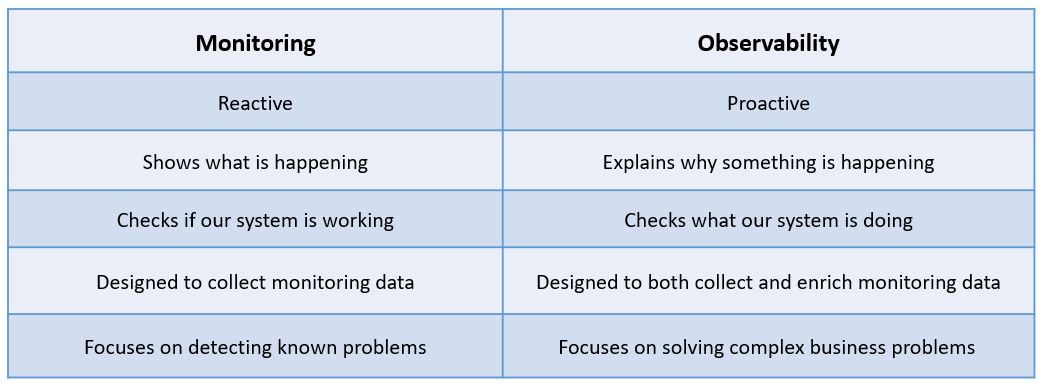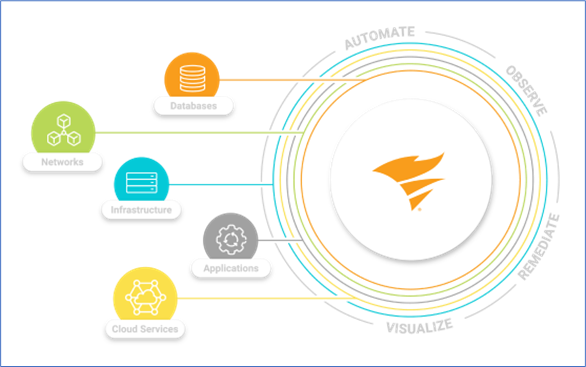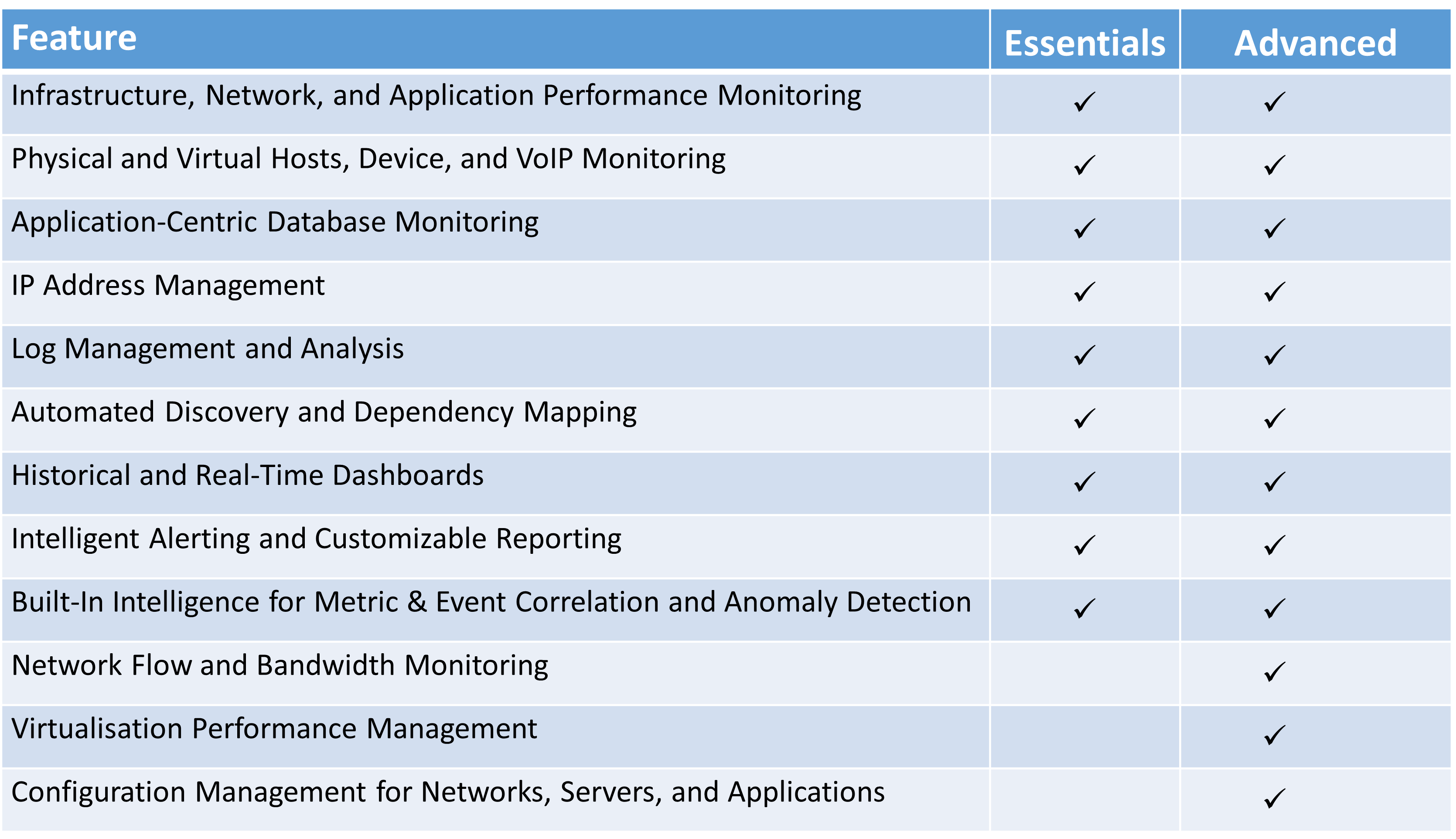Beginning of a New Era: SolarWinds Hybrid Cloud Observability
SolarWinds® announced the new Hybrid Cloud Observability solution in October 2022 which provides significant changes in the approach of the classical monitoring solution. In this blog post, we would like to discuss the requirement for an Observability solution with its features, benefits and licensing models.
Monitoring vs Observability
I think the best starting point for our topic is the comparison of observability and monitoring. Let’s start with the following table which provides a high-level comparison of these two terminologies:

In comparison to monitoring, observability is a proactive system as it does not rely on collected data only. By the help of Machine Learning (ML) and Artificial Intelligence for IT Operations (AIOps), it enriches monitoring data and provides actionable insights to solve complex business problems. By this way, we expect to see the root cause of a problem without human interaction in a good observability solution.
Why is Observability (more) important today?
The main reason for the requirement for observability is the increasing complexity of IT systems and infrastructure. Maybe a decade ago, capturing individual data points using traditional polling was sufficient to identify problems. But today, organisations are on a transformation journey, moving from big monolithic applications to multi-server/serverless consumption, from legacy on-premise services to cloud-based distributed services. There are more data points than ever to capture today, and multiple tools are often used to manage and maintain the monitoring of different systems with the classical monitoring approach.
That’s why we need a mature observability solution which can aggregate events, provide anomaly detection, recommend improvements, forecast future requirements and score the analytical health of distributed services with a single presentation overlay. This observability solution can enable organisations to move from a self-interpretation reactive scenario to a proactive approach with the help of visibility and actionable insights across the full IT stack.
SolarWinds® Hybrid Cloud Observability
SolarWinds HCO is designed to visualise, observe, remediate and automate IT environments running on-premises and cloud resources. It provides a centralised overlay using node-based licensing, and it should be considered as a better version of the traditional SolarWinds Orion platform with additional features to enhance capabilities into AIOps and Machine Learning, ensure availability and optimise performance.

Main Features
SolarWinds HCO provides the following features for organisations that are planning a transformation in IT services:
- Observability for all
- Easy to use
- Full stack and integrated
- Deployment freedom
- Superior Value
- Actionable intelligence
It is designed for organisations in different phases of the digital transformation journey, and it provides benefits for people in different roles in an organisation.
It is easy to access and get visibility to the overall status of IT services with the capability of customising the user interface for different user roles.
It covers the observability of networks, infrastructure, databases, applications and cloud services with the integration capability for collected data from different layers.
With its node-based licensing and easy evaluation mechanism, greater choice on platform architecture, scaling, and development deployment is provided.
As a single product for full stack observability, it delivers a platform for accurate, rapid response to potential service availability, health and performance problems and lowers the maintenance cost of the solution.
By the help of the AIOps service integration, it allows anomaly detection for IT services and helps to optimise the environment efficiently.
Benefits:
By the help of the new features, SolarWinds HCO has the following benefits for organisations:
- Accelerate issue resolution
- Eliminate tool sprawl
- Reduce alert fatigue and risk
- Gain deployment flexibility
- Help ensure service levels
- Be more productive and agile
It provides a full stack and holistic visibility to IT services and focuses on key issues that help IT administrators to identify the root cause of the problems quickly.
SolarWinds HCO is a unified solution to visualise networks, infrastructure, applications, databases and cloud services and it simplifies the multiple tool requirement problem in the classic monitoring approach.
With the help of the AIOps supported anomaly-based alerts and the capability of mapping dependant objects, it helps to reduce alert storms and focus on real and potential problems.
SolarWinds HCO supports on-premises or in-the-cloud deployments, and it makes license management easier with a node-based approach. It also allows scalability to include more nodes without geographical or client-based limitations.
With the help of holistic insights and a proactive approach, it improves MTTR and ensures SLAs for complex services.
As it provides a user-friendly interface for different roles in an organisation, it improves coordination between different teams and increases effectiveness. Integration with ITSM tools also helps to improve existing processes.
Licensing:
SolarWinds HCO has two licensing models; “Essentials” and “Advanced”. Features supported by each licensing model are shown in the table below.

- Polling Engines
- Additional Web Server
- High Availability
- Enterprise Operations Console
- Premier Support
- Lab License
Conclusion
SolarWinds Hybrid Cloud Observability is a new approach by SolarWinds. Existing Orion customers can still continue to use module-based licensing model. SolarWinds HCO provides simplicity with node-based licensing and moreover, it allows integration with SolarWinds AIOPS service, which is the first step for a full observability solution to enable organisations to move from a classic monitoring approach to observability which will help them to apply automation as the next step.

Ecmel Ozdemir
Senior SolarWinds Engineer
Ecmel Ozdemir is a Senior SolarWinds Engineer at Prosperon Networks. As a SolarWinds Engineer for over three years, Ecmel has helped hundreds of customers meet their IT monitoring requirements with SolarWinds.
Demo: SolarWinds Hybrid Cloud Observability
Demo: SolarWinds Hybrid Cloud Observability
Enhance Database Monitoring with SolarWinds SQL Sentry
Recent Improvements to SQL Sentry In the fast-paced world of database management, staying on top of performance monitoring and optimisation is crucial. Database...
Database in Distress – important Database metrics on one screen with SolarWinds
Webinar: Database in Distress How to understand important Database metrics on one screen with SolarWindsIn this Webinar on Monday 5th June, you will discover how SolarWinds®...
Webinar On-Demand: SolarWinds Database Monitoring – Actual Bona Fide Database Administrators
In this webinar, you will discover how SolarWinds® can help Database Administrators to meet their advancing Database monitoring and configuration challenges. This webinar...
